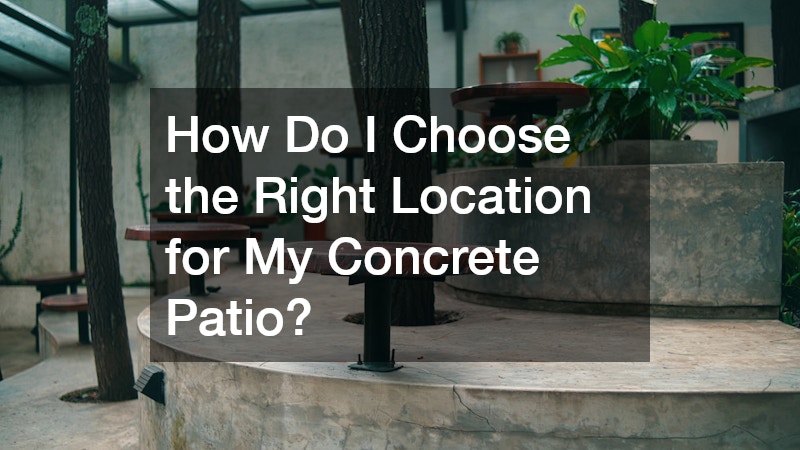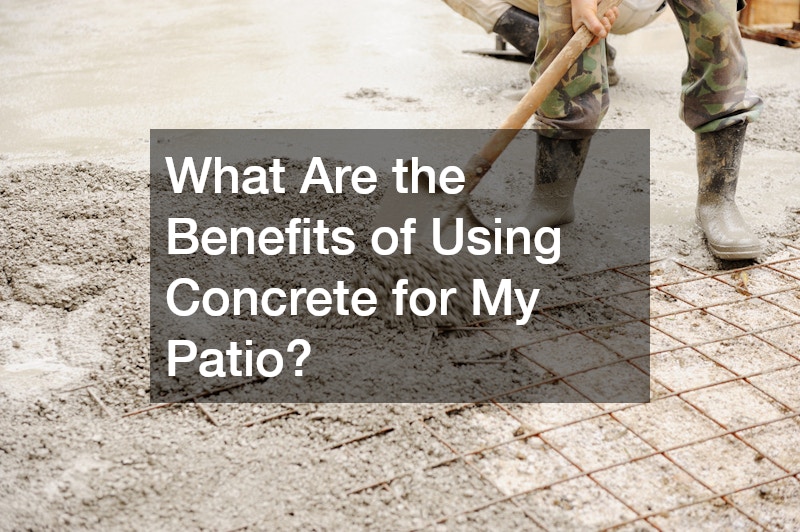An inviting outdoor area is more than just a backyard — it’s an extension of your home where you can relax, entertain guests, and connect with nature. A concrete patio provides the perfect foundation for creating a welcoming and versatile space. Durable, affordable, and highly customizable, a concrete patio can be tailored to suit any aesthetic, from modern minimalism to lush garden retreat.
Designing an outdoor area that combines beauty and functionality takes planning and creativity. It’s about choosing the right materials, arranging seating for comfort, adding decorative elements, and incorporating plants and lighting to set the mood. Whether you’re starting from scratch or upgrading an existing space, thoughtful design can transform your patio into a favorite spot year-round.
This article offers expert tips to help you create an outdoor area centered around a concrete patio. From choosing the ideal location to incorporating privacy features, lighting, and seating, you’ll find inspiration and practical advice to make your vision a reality. We’ll also explore ways to integrate other features like hardscape elements, an irrigation system, and even advice from a landscape designer to ensure your space feels cohesive and inviting.
How Do I Choose the Right Location for My Concrete Patio?

Considering Sun Exposure
Before pouring a concrete patio, observe how sunlight moves across your yard. Areas that get morning sun and afternoon shade often feel the most comfortable. If your chosen spot is very sunny, you can plan to add an exterior sun shade or plant trees to provide relief from the heat. Positioning the patio to take advantage of natural light while avoiding harsh afternoon rays is key.
Accessibility From the Indoor Space
The best patios feel like a seamless extension of your home. Ideally, your concrete patio should connect directly to a main living area, such as through doors for a patio or sliding glass doors. Easy access encourages more frequent use and simplifies moving food, drinks, and furniture in and out.
Evaluating the Ground and Soil Conditions
Choose a level area with stable soil to minimize the risk of cracks or uneven surfaces later. If the ground has drainage issues, it’s worth consulting a landscape designer or local tree services to assess and amend the soil before installation. Proper site preparation ensures your patio remains durable for years to come.
What Are the Best Design Ideas for a Concrete Patio?
Incorporating Textures and Patterns
Stamped or textured finishes can make a concrete patio look like natural stone, brick, or even wood. Adding patterns breaks up large expanses of plain concrete, giving your space more visual interest. A hardscape professional can help you select the best finishes. They typically also work with natural, floral elements, so they can also provide landscaping design tips.
Integrating Multiple Levels
If you have a sloped yard, consider a multi-level design. Each level can serve a different purpose — dining, lounging, or gardening. Raised platforms, steps, and retaining walls add dimension and functionality.
Adding Greenery and Planters
Plants soften the hard edges of a concrete patio. Use the best raised garden bed or large containers to bring color and life into the space. Incorporating greenery also improves air quality and makes the area feel cooler and more relaxing.
How Can I Ensure My Concrete Patio Is Durable?
Understanding Concrete Mix and Reinforcement
The strength of your patio depends on the quality of the mix and reinforcement materials. Reinforcing mesh or rebar increases the patio’s resistance to cracking. Working with an experienced contractor or hot tub dealer (if including a spa) ensures proper techniques are used.
Proper Sealing Techniques
Seal your concrete patio to protect it from moisture, stains, and UV damage. A high-quality sealer applied every few years helps maintain its appearance and longevity.
Maintenance and Care Tips
Regular sweeping, occasional power washing, and resealing when needed will keep your patio looking fresh. Avoid using harsh chemicals that could damage the surface, and trim back nearby trees or bushes to prevent staining from leaves and sap.
What Are the Benefits of Using Concrete for My Patio?

Affordability and Versatility
Concrete is often more affordable than natural stone or pavers, making it an excellent choice for budget-conscious homeowners. It also offers unmatched versatility in shape, size, and finish.
Longevity and Low Maintenance
A properly installed and maintained concrete patio can last decades with minimal upkeep. Unlike wood decks, it won’t warp or rot and is resistant to pests and fire.
Creative Design Flexibility
With techniques like staining, stamping, and engraving, concrete offers countless creative options. You can even incorporate an irrigation system beneath or around your patio to keep surrounding plants healthy without visible hoses or sprinklers.
How to Enhance Privacy and Comfort on My Patio?
Utilizing Outdoor Curtains and Blinds
Outdoor curtains, blinds, or an exterior sun shade add privacy and help block wind or harsh sunlight. These features can also bring a soft, cozy feel to your patio area.
Planting Hedges and Trees
Strategically planting hedges or using local tree services to install fast-growing trees around your patio creates a natural privacy screen. Greenery also reduces noise and makes the space more inviting.
Installing Free-Standing or Wall-Mounted Screens
Decorative screens provide privacy and serve as a stylish backdrop. Available in wood, metal, or composite materials, screens can also define different zones within your outdoor area.
What Are Some Lighting Options for a Concrete Patio?
Utilizing Solar-Powered Lights
Solar-powered stake lights or path lights offer eco-friendly illumination without the need for wiring. They’re perfect for accentuating pathways and edges of your patio, creating a safe walking area at night while adding subtle charm. Many models now come with adjustable brightness and color temperatures, giving you more control over the look and feel of your space. You can also place solar lights near raised garden beds or around hardscape elements to create dramatic shadows and highlights. Because they recharge during the day, they’re cost-effective and ideal for spots far from electrical outlets.
Installing String or Fairy Lights
String lights add charm and a festive atmosphere. Drape them over doors for a patio, pergolas, or between poles to create a canopy of light that feels warm and inviting. You can weave them through trellises, wrap them around tree trunks, or even hang them vertically like a curtain for a unique effect. Using outdoor-rated LED string lights ensures they last longer and withstand weather conditions. Combined with other lighting, they help define zones and make dining or lounge areas cozy and enchanting, perfect for both everyday use and entertaining.
Using Lanterns and Candles for Ambiance
Lanterns and candles bring warmth and a soft glow. Group them on tables or around the perimeter of your concrete patio to create an intimate, relaxing mood. Opt for flameless LED candles for safety and longevity while still achieving the flickering effect of real flames. Large floor lanterns can also double as decorative accents, framing doorways or anchoring seating areas. Mixing lantern sizes and styles adds visual interest, and placing them along pathways can subtly guide guests while enhancing the overall ambiance of the space.
How Can I Incorporate Seating Arrangements on My Patio?

Choosing Weather-Resistant Furniture
Opt for furniture designed to withstand outdoor conditions. Materials like teak, aluminum, and resin wicker resist moisture and UV rays.
Adding Built-In Seating Options
Built-in benches or seat walls made of concrete or stone save space and create a cohesive look. You can even integrate storage beneath the seating.
Arranging Flexible and Modular Seating
Modular furniture allows you to adapt the layout for different occasions, whether it’s a cozy evening for two or a larger gathering.
What Decorative Elements Can Enhance My Patio’s Aesthetics?
Incorporating Outdoor Rugs and Cushions
Rugs and cushions add comfort and personality to your patio, making it feel like an extension of your indoor living space. Outdoor rugs help define zones on the patio, while cushions provide softness and visual interest. Opt for materials designed to resist fading, moisture, and mildew so they’ll last through different weather conditions. Layering rugs of different textures or patterns can create a designer feel, while mixing and matching cushion colors can bring energy and warmth to the seating areas. These simple additions make even a plain concrete patio feel cozy and stylish.
Using Water Features and Fire Pits
A water fountain or a fire pit adds a sensory element to your patio. The sound of water creates a soothing backdrop that helps drown out noise, while a fire pit offers warmth and a gathering point for cooler evenings. Choose a fire pit design that complements the shape and materials of your patio, whether it’s a portable metal bowl or a permanent stone feature. Small fountains can be tucked into a corner or integrated into a garden bed nearby, enhancing the overall ambiance while requiring minimal maintenance.
Displaying Wall Art and Sculptures
Outdoor-friendly wall art, sculptures, or even vertical gardens bring artistry and character to a concrete patio, making it truly unique. Hang weather-resistant metal or ceramic pieces on fences, walls, or the back of your home to add visual interest without taking up floor space. Free-standing sculptures can act as focal points or frame specific areas of your patio. If you prefer something functional, consider decorative screens that double as privacy barriers while showcasing creative patterns or cutouts, blending beauty and practicality seamlessly.
How Can I Create a Multi-Functional Patio Space?
Zone Design Planning
Plan different zones for dining, lounging, gardening, and even cooking to make the most of your outdoor space. Using outdoor rugs, planters, or changes in elevation helps define each area while keeping the design cohesive. For example, you might position a dining set closest to doors for a patio for easy access to the kitchen and create a separate lounging area with comfy chairs under an exterior sun shade. Thoughtful zoning allows you to accommodate both quiet relaxation and lively gatherings without the spaces competing with each other.
Incorporating an Outdoor Kitchen
An outdoor kitchen with a grill, counter space, and storage adds value and convenience to your patio. Whether you install a full kitchen with built-in appliances or keep it simple with a freestanding grill and prep table, it elevates your entertaining options. Include durable countertops, ample lighting, and weather-resistant cabinets to make the area functional and easy to maintain. Adding barstools around a counter also encourages guests to linger while you cook, making the kitchen area feel just as welcoming as your indoor spaces.
Installing a Retractable Awning or Pergola
Adding a retractable awning, pergola, or exterior sun shade lets you control sun exposure and defines the space architecturally. A pergola covered with climbing plants creates a natural canopy that adds both beauty and shade, while retractable awnings give you flexibility to enjoy the sun or shelter when needed. You can even integrate string lights or hanging plants into these structures to enhance their visual appeal and make the patio feel more like an outdoor room. These features also help make your patio usable year-round by providing protection from the elements.
What Safety Considerations Should I Keep in Mind?

Ensuring Non-Slip Surfaces
Textured finishes and mats reduce the risk of slipping, especially when the surface is wet. This is particularly important if you’re installing a hot tub or near a pool.
Checking for Proper Drainage
Poor drainage can lead to puddles and damage. Make sure water flows away from your home and patio. An irrigation system can also help manage runoff and keep surrounding plants healthy.
Installing Safe Outdoor Lighting
Adequate lighting ensures safe movement around your patio after dark. Use a mix of path lights, step lights, and overhead fixtures for complete coverage.
Conclusion
Designing an inviting outdoor area with a concrete patio is an opportunity to create a beautiful, functional space that reflects your lifestyle and enhances your home. By thoughtfully choosing the location, incorporating durable materials, and considering design elements like greenery, lighting, and seating, you can craft a patio that’s both practical and appealing.
Remember to prioritize comfort and privacy by adding features like curtains, hedges, or screens. Make your space multi-functional with dedicated zones for dining, lounging, and gardening, and don’t forget to include decorative touches that express your personality. A concrete patio offers endless possibilities for creativity, durability, and enjoyment.
Whether you’re working with a landscape designer or taking a DIY approach, integrating additional elements like an irrigation system, hardscape accents, and advice from local tree services can elevate the overall experience. With careful planning and attention to detail, your backyard can become a cherished retreat where you’ll love spending time for years to come.


